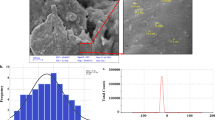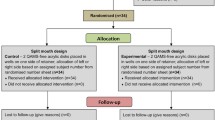Abstract
The study aimed, firstly, to monitor the release of an antifungal drug, fluconazole, from a self-polymerizing poly(methyl methacrylate) (PMMA) denture base resin in artificial saliva and comparing it with the release in water; and secondly, to investigate the effect of the released drug on the growth of resistant and standard strains of Candida albicans. A high-performance liquid chromatography–ultra-violet (HPLC–UV) method was used in the analysis of the released eluates into distilled water from self-polymerized PMMA discs doped with the 10% fluconazole antifungal drug. The efficacy of the released drug against resistant and standard strains of C. albicans was monitored, using agar diffusion method. The results showed that fluconazole, can be successfully incorporated with the self-polymerized PMMA. The findings suggest that the drug leaches steadily out of the PMMA resin into artificial saliva and distilled water at mouth temperature and that sustained drug release continued throughout the 28 days test period. It was shown that the released drug demonstrated antifungal activity against both standard and resistant C. albicans. The findings of this investigation have a clinical value in terms of their significant contribution to the treatment of fungal infections of the oral cavity. The sustained release of antifungal drug from the PMMA resin clearly constitutes a new dosage form of the drug via the poly(methyl methacrylate) delivery system.





Similar content being viewed by others
References
Budtz-Jørgensen E. The significance of Candida albicans in denture stomatitis. Scand J Dent Res. 1974;82:5–51.
Budtz-Jørgensen E, Theilade E, Theilade J. Regional variations in viable bacterial and yeast counts of 1-week-old denture plaque in denture stomatitis. Scand J Dent Res. 1983;91:288–95.
Pollack B, Buck IF, Kalnius J. An oral syndrome complicating pschopharmacotherapy study II. Am J Psychiatry. 1964;121:384–6.
Budtz-Jørgensen E, Theilade E, Theilade J. Quantitative relationship between yeasts and bacteria in denture-induced stomatitis. Scand J Dent Res. 1983;91:134–42.
Bergendal T, Holmberg K, Nord CE. Yeast colonization in the oral cavity and feces in patients with denture stomatitis. Acta Odontol Scand. 1979;37:37–45.
Brook IM, van Noort R. Controlled delivery of drugs. Br Dent J. 1984;157:11–5.
Garcia CR, Siquerios A, Benet LZ. Oral controlled release preparations. Pharm Acta Helv. 1978;53:99–109.
Paul DR. Polymers in controlled release technology. American Chemical Society Symp.; Series No. 33 controlled release polymeric formulations; 1976. p. 1–3.
Douglas WH, Walker DM. Nystatin in denture liners—an alternative treatment of denture stomatitis. Br Dent J. 1973;135(2):55–9.
Douglas WH, Clarke DA. Physical and mechanical properties of nystatin containing denture liners. J Prosthet Dent. 1975;34:428–33.
Thomas CJ, Nutt GM. The in vitro fungicidal properties of Visco-gel, alone and combined with nystatin and amphotericin B. J Oral Rehabit. 1978;5:167–72.
McCarthy JA, Moser JB. Tissue conditioning and functional impression materials. In: Dent Clin North Am: removable prosthodontics. Toronto: Saunders; 1984.
Quinn DM. The effectiveness, in vitro, of tniconazole and ketoconazole combined with tissue conditioners in inhibiting the growth of Candida albicans. J Oral Rehabil. 1985;12:177–82.
Okita N, Orstavik D, Orstavik J. In vivo and in vitro studies on soft denture material: microbial adhesion and tests for antibacterial activity. Dent Mater. 1991;7(3):155–60.
Schneid TR. An in vitro analysis of a sustained release system for the treatment of denture stomatitis. Spec Care Dentist. 1992;12:245–50.
Truhlar IMR, Sahy K, Sohnle P. Use of a new assay technique for quantification of antiflungal activity of nystatin incorporated in denture liners. J Prosihcl Dent. 1994;71:517–24.
Nikawa HT, et al. Antifungal effect of zeolite-incorporated tissue conditioner against Candida albicans growth and/or acid production. J Oral Rehabil. 1997;24:350–7.
Kulak Y, Kazazoglu E. In vivo and in vitro siud of fungal presence and growth on three tissue conditioning materials on implant supported complete denture wearers. J Oral Rehabil. 1998;25:135–8.
Chow CKW, Matear DW, Lawrence HP. Efficacy of antifungal agents in tissue conditioners in treating candidiasis. Gerodontology. 1999;16(2):111–8.
Geerts GA, Stuhlinger MF, Basson NJ. Effect of antifungal denture liner on the saliva yeast count in patients with denture stomatitis: a pilot study. J Oral Rehabil. 2008;35:664–9.
Riggs PD, Braden M, Patel M. Chlorhexidine release from room temperature polymerizing methacrylate systems. Biomaterials. 2000;21:345–51.
Patel MP, Cruchley AT, Coleman DC, Swai H, Braden M, Williams DM. A polymeric system for intra-oral delivery of an anti fungal agent. Biomaterials. 2001;22:2319–24.
Shellis RP. Synthetic saliva for cultural studies of dental plaque. Arch Oral Biol. 1978;23:485–9.
Amin WM. A study of adhesion between soft lining materials and poly(methyl methacrylate). PhD thesis, University of London; 1987.
Alawi MA, Amin WM. Effect of aging on monomer elution from poly(methyl methacrylate) resin under simulated intra-oral conditions. FEB. 2007;16:408–14.
Brook IM, Van Noort R. Drug release from acrylic polymers via channels and cracks: in vitro studies with hydrocortisone. Biomaterials. 1985;6:281–5.
Lamb DJ, Martin MV. An in vitro and in vivo study of the effect of incorporation of Chlorhexidine into autopolymerizing acrylic resin plates upon the growth of Candida albicans. Biomaterials. 1983;4:205–9.
Author information
Authors and Affiliations
Corresponding author
Rights and permissions
About this article
Cite this article
Darwish, R.M., Amin, W.M., Al-Ali, M.H. et al. Study of the elution of fluconazole from a self-polymerizing acrylic resin and its activity against resistant Candida albicans . J Mater Sci: Mater Med 22, 1885–1890 (2011). https://doi.org/10.1007/s10856-009-3893-z
Received:
Accepted:
Published:
Issue Date:
DOI: https://doi.org/10.1007/s10856-009-3893-z




